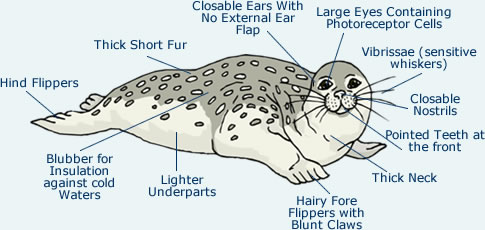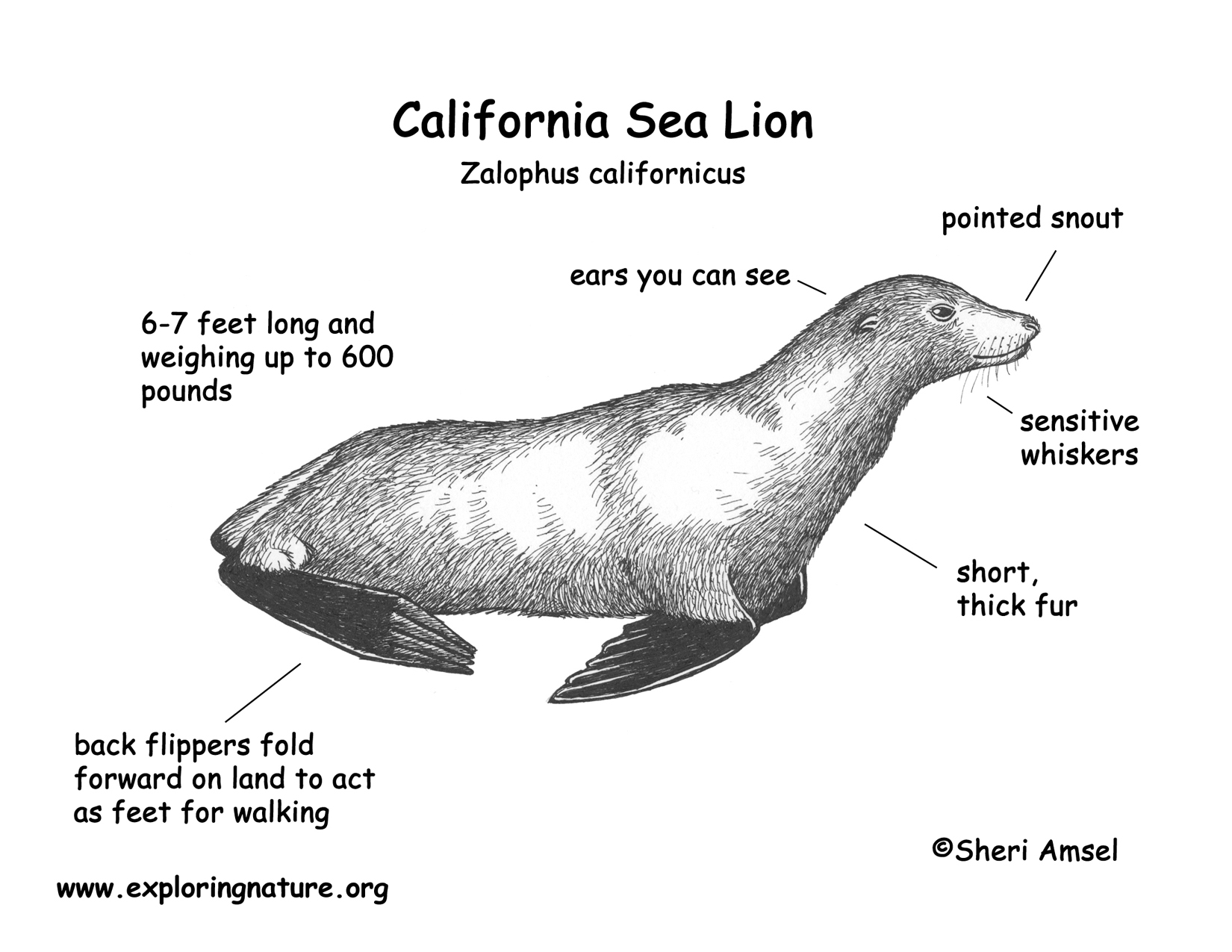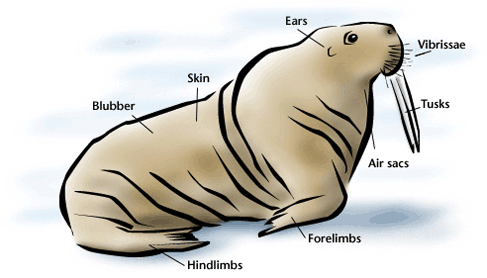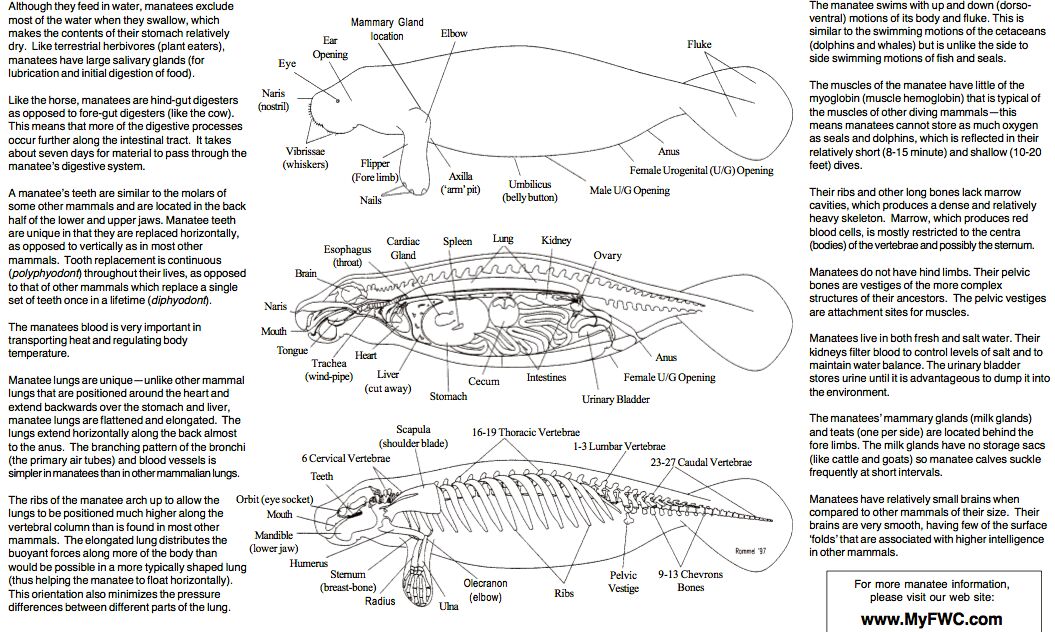Marine Mammals
Example marine mammals: Seals, Sea Lions, Walruses, Otters, Manatees, Polar Bears, Dugongs, Whales, Dolphins
- Homeotherms
- Body temperature stays at a constant level
- Most marine mammals have a thick layer of blubber to keep body temp warm
- Reproduction: Viviparous
- Live birth: Offspring develops inside the body before birth
- Mammary glands
- Females produce milk containing essential nutrients for the offspring
- Sexual Dimorphism
- Males and females look different
- Examples: Size, Color, etc
- Order: Pinnipedia
- "fin-footed"
- Seals, sea lions, walruses
Anatomy of a Seal
Anatomy of a Sea Lion
- Seal and Sea Lion Diet
- Carnivores (meat eaters)
- Fish, squid, octopus, crustaceans, and occasionally other pinnipeds
Characteristic |
Seal |
Sea Lion |
Ears |
Ear holes |
Ear flaps |
Front Flippers |
Stubby front flippers with claws on each toe |
Elongated front flippers without claws |
General Body Shape |
More streamlined |
More agile |
Where They Hang Out |
Spend most of their time in the water |
Bask in the sun |
On Land |
Galumph: ‘belly crawlers’ |
Walk |
Walking |
Can't |
Sea lions are able to ‘walk’ on land more easily because they can rotate their hind flippers underneath their bodies. |
Vocalization |
Grunt/chirp |
Bark |
Socialization |
Solitary and shy towards humans |
Gather in large groups called rafts or herds of up to 1,500 animals |
Walruses
- Characteristics
- Large, Robust Body
- Reddish-Brown coloration
- HUNDREDS of vibrissae (whiskers)
- Both male and females have large tusks
- Diet
- Mainly eat bivalve mollusks (clams, oysters) and other invertebrates like marine worms, snails, sea cucumbers, squid, and crab
Order: Carnivora
- Sea otters and polar bears
- Sea otters
- Characteristics
- Very fine, dense fur coats with 2 layers. (one for warmth and one oily top coat to keep water away from the skin)
- Small front feet with retractable claws
- Flipper-like, broad and webbed back feet
- Diet
- urchins, abalone, mussels, clams, crabs, snails
- eat approximately 25% of their weight in food each day
- males can weight up to 100lbs
- Keystone species
- Keystone Species: A species whose role in the environment is essential for maintaining structure and function in an ecosystem
- Sea otters prey on the species that would otherwise destroy kelp forests.
- Kelp forests provide food and shelter for many different marine species.
- Other facts
- While sleeping, sea otters hold hands so that they do not drift apart from one another
- A group resting together is called a raft
- Sea otters have pockets under their arms where they keep their ‘favorite rock’ which they use as tools to open and eat shells
- Polar Bears
- Characteristics
- Order: Carnivora
- Largest land carnivore
- Spend most of time on ice, but depend on the ocean to survive
- Males (800-1500 lbs) are significantly larger than females (300-550 lbs)
- Adaptations for cold weather
- Fur and skin
- The hair of a polar bear is actually hollow and TRANSLUCENT
- Their skin is BLACK. (To attract sunlight for warmth)
- It only appears white due to the way light reacts with their fur
- This helps them to blend in with their surroundings
- Feet
- Thick padding on feet to insulate from cold
- Wide paws and hair between pads on paws to prevent from slipping
- Tiny ears
- To reduce heat loss
- Adaptations for aquatic life
- Claws and strong legs to help swim and catch prey
- Diet
- Seals, whale carcass, beluga
- They do NOT typically eat fish
- Breeding
- Females breed once every 3 years
- They are pregnant for 8 months
- Most common litter size: 2
- Cubs stay with mom for ~30 months
Order: Sirenia
- Manatees and dugongs
- Characteristics
- Large body
- Completely aquatic (never on land)
- Tough thick skin with little hair
- No hind limbs
- Flattened tails
- Nostrils on top of snout with nasal plugs
- Mammary glands located in ‘armpits’
- 4 species remain
- Endangered or Threatened
- Amazonian Manatee
- West African Manatee
- West Indian Manatee
- Dugong
- Extinct
- Steller's Sea Cow
- Steller’s sea cow went extinct in the 1700s due to overhunting
- Measured 30 ft long
- Diet
- Herbivores
- Only eat PLANTS
Characteristic |
Manatee |
Dugong |
Feeding |
feed at all water depths |
feed exclusively on what is at the bottom of the water |
Tail |
Rounded tail |
Dolphin-like fluke |
Nails |
have nails on forelimbs |
do not have nails |
Teeth |
|
|
Mouth |
Short snout |
Broad downward- facing trunk-like snouts |
Life Span |
~50 years |
~70 years |
Size |
Larger (11 feet) |
Smaller (8 feet) |
Location |
Tropical Atlantic and Pacific |
Indian Ocean and Western Pacific |
Reproduction |
Females: Produce 1 calf every 2-5 years Males: have several female partners |
Females: Produce 1 calf every 3-7 years Males: are monogamous |
Biggest threat: Sirenias are often injured by the propellers of boats




